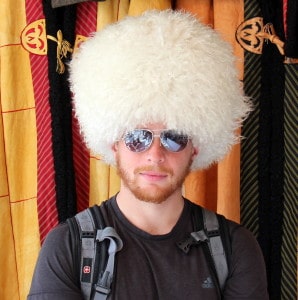Kumtor Gold Mine:
Kyrgyzstan’s Fine Line Between Ecology and Economy
Standing squarely at the heart of countless clashes, the Kumtor Gold Mine is equally one of Kyrgyzstan’s most important economic contributors and one of its most controversial environmental and investment considerations.
The Kumtor Gold Mine is located high in the mountains to the south of Issyk-Kol, 50 miles up a rugged winding road from the district of Tong (1,740m / 5,710ft above sea level) on the shore of the lake to the open-pit mine above 4,000m / 13,000ft just below the Davidov glacier.
That location in the permafrost zone sits close to a glacier that serves as a water source for the Naryn River (Kyrgyzstan’s longest) that flows through the country and on into Tajikistan and Uzbekistan downstream. In only the first year of Kumtor’s operation, a truck carrying a cyanide-based solution crashed into the Barskoon River – an inauspicious start that from the beginning of the operation highlighted the potential environmental consequences of mining activities in such a fragile environment.
Add to this complaints from the communities nearest to Kumtor (Barskoon, Tamga, Tosor) that the mine doesn’t do enough for local communities, or that it does too much for communities farther away from the site; government demands to nationalize more shares of the company into the hands of state-owned Kyrgyzaltyn; and ongoing concerns dealing with the unclear legal situation of other mining licenses in the country for both gold (at Jerooy) and heavy rare earth minerals (at Kutessay).
The situation surrounding Kumtor, who currently projects operations on the site until 2026, often seems unclear even through the current operating year. At the moment, the government is effecting a swap of its current 32.7% stake of parent company Centerra Gold for a 50% stake in the Kumtor mine itself. Though projections presumably show that the Kyrgyz government would thus earn more money in the short-term production of the mine through 2026, it also raises questions about what will develop to replace that revenue after the mine stops operations.
The Kumtor mine, which consistently accounts for around 12% of Kyrgyzstan’s GDP, also employs over 2,600 local workers and nearly 500 contractors on site. According to Director of Sustainable Development Doug Grier, this GDP figure also ignores larger considerations such as employee spending / entrepreneurial activities and local sourcing of materials used on site – both areas the company is currently focusing on in view of the eventual closure of the mine and the need to leave communities in the region able to function economically once Kumtor stops mining.
The community impact of the mine’s contributions on the south shore of Issyk-Kol is obvious: refurbished schools, libraries stocked with books printed by Kumtor, and support for wildlife protection programs in the nearby Sarychat-Ertash State Nature Reserve (prime territory for snow leopards in Kyrgyzstan).
These positive contributions, both in financial terms and in promoting the strategic long-term development of south shore communities, seem obvious to me (as an outsider) even if residents of nearby areas seem to sometimes complain that they’re hardly enough. They do not, however, erase the real questions of environmental sustainability that the mine raises.
Nobody will deny, it seems not even the people at Kumtor, that the high altitudes of the Tian Shan mountains are a fragile environment. In a region where water rights and usage are a constant source of squabbling, the potential damage to ice reserves and rivers in an era of already accelerating glacial melt has consequences not only for Issyk Kul and Kyrgyzstan but really for the entire Central Asia region. Kumtor is one of the highest-altitude gold mines anywhere in the world (second only to a mine in Peru), the largest gold deposit in Kyrgyzstan, and the largest such mine in Central Asia operated by a Western firm. The considerations here are large in scope.
Mining and milling of gold-bearing ore happen on site at Kumtor, while processing of the gold doré happens at the Kyrgyzaltyn refinery in Kara-Balta (to the west of Bishkek in the Chuy Valley) a bit over 400km away. Not only is there impact from the mining itself, then, but also from the work of and infrastructure necessary for milling the ore and in transporting it along roads that induced vertigo even in late fall when I visited – one assume the snowy Kyrgyz winter makes the trip even more difficult.
Sodium cyanide, an integral part of the gold milling process, must be transported to the mine site itself for use and then disposed of locally in a way that doesn’t cause damage to wildlife in the area or the humans that live downstream. Residents of the Barskoon area still complain of ill effects from the cyanide spill in 1998.
(There have also been accusations that the company doesn’t even maintain their facilities on site, though I saw no evidence of that during my visit.)
All things considered, it does seem reasonable for locals in the area to be concerned. After all, if there were any sort of catastrophic failure at Kumtor it would be the people of Barskoon and Issyk-Kul that would feel it most immediately.
I certainly don’t have answers here, just half-informed opinions. As an outsider observer with a strong interest in Kyrgyzstan I’m torn between the desire to see this amazing little country prosper economically and concern for the unique natural beauty that went a long way towards pulling me here in the first place.
The Kumtor gold mine sits at the intersection of these two competing interests, like many industrial activities in the region have before. Close to Barskoon, the Soviet-era uranium plants near the village of Kadgy-Sai still poses a contamination potential despite the fact that processing stopped there in 1967. The village of Inilchek, on the other hand, was a prosperous mining town in the mountains to the east of present-day Kumtor until the early 1990’s when the local tin mine stopped production. For the twenty families that still remain of the five thousand people that once lived there, the lost economic opportunities have certainly had a significant impact on their lifestyles and prosperity.
Which of these two scenarios will play out when the gates of Kumtor finally close? A complicated question, and one that depends largely on the ongoing interaction between Centerra, the Kyrgyz government, and the residents of Issyk Kul’s southern shore that are most directly affected by the answers.
The only thing one can really be certain of, in the end, is that it will definitely be in the news.
Practical Information:
I visited Kumtor as one member of a larger delegation organized through my employer in Bishkek. As one might expect, access to Kumtor is tightly controlled with a number of checkpoints and security posts on the road between Issyk-Kol and the mine site itself.
Most travelers visiting this area will base themselves at one of the number of guesthouses in Karakol, though there is a great place to stay in Tamga as well. Though the immediate surroundings of Kumtor are inaccessible, the entire south shore and the mountains to the east of Karkaol are full of amazing hiking for those willing to work a bit for it.












Stephen, I enjoyed this article.
Not back to myself yet after the fall. Will write you a long note to catch you up when I can. Miss you. The ole woman.